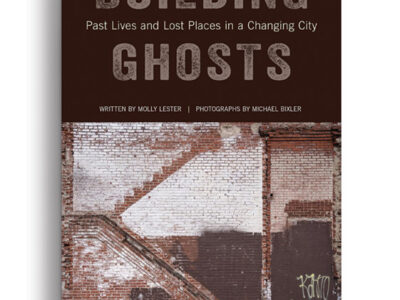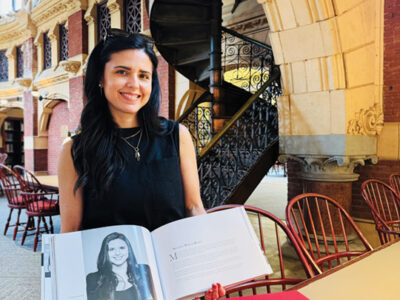Could a team of Penn architecture students learn enough from the quintessential Jersey Shore-town’s pop-culture past to guarantee its future?
By George Thomas

On a late-summer night, the red disc of a giant Ferris wheel floats like a harvest moon over the marshes, inlets, and cottages that form the three contiguous towns known as the Wildwoods. From its top, 20 stories in the air, a rider can see the glittering casinos of Atlantic City to the north and Cape May’s brightly-colored Victorian cottages to the south.
Forty years ago, the Wildwoods were the South Jersey mecca for blue-collar workers who had enough extra dollars from the Philadelphia industrial economy to vacation at the New Jersey shore. The opening of the Garden State Parkway, the ever-more casual American society, and the automobile itself led to the motel revolution that is the enduring artifact of present-day Wildwood.
Arriving at pop architecture before pop culture was recognized, Wildwood’s motels captured the anti-historicism of the modern age. With American Bandstand broadcast from the Arena on Market Street and Grace Kelly, the movie actress from East Falls, marrying a crown prince, Philadelphia was a center of pop culture. Wildwood’s motels capitalized on these images — the Monaco, festooned with purple trim and a gold crown; the Three Coins (from the song “Three Coins in the Fountain”); even The Packard, since in such an intensely commercial environment, trade names could sell. In 1957, cultural historian J. B. Jackson adapted sociologist David Riesman’s terminology of self-definition to architecture, proclaiming in his essay “Other Directed Houses” that a modern vacation style had arrived. So successful was Wildwood that, by the 1960s, Cape May leaders wanted to demolish their Victorian buildings to become Wildwood-south.
Yet as the twentieth century ends, Cape May’s restored Victorian bed-and-breakfasts enjoy a 10-month season, while the teen/youth-oriented, summer-vacation focus of Wildwood limits its season from Memorial Day to Labor Day, with a modest spillover to Columbus Day. Wildwood’s promoters have compared their community to that of their neighbors and found that it lacks not only the year-round lure of gambling offered by nearby Atlantic City but also the gentle Victorian charm of Cape May that so appeals to middle-aged Boomers and empty-nesters.
Wildwood faced other problems as well. High culture has a half-life (to borrow a term from nuclear physics) measured in centuries; we still recognize Greek temples and medieval knights. Ever-changing pop culture, on the other hand, has a half-life measured in decades. By the 1990s, much of Wildwood’s 1950s “Doowop” imagery was meaningless to the public, while the carnival atmosphere frightened off many customers. The resort’s leaders had to ask themselves a painful question: Should the Wildwoods be reinvented?
To inform their perspective and separate the pearls from the oyster shells, the Morey Organization — operator of amusement piers and developer of Sea Pointe at the south end of the island — turned to a Penn architecture studio led by Steven Izenour of Venturi, Scott Brown and Associates. Back in 1968, Izenour was a participant in the Yale studio led by Robert Venturi, Hon’80, and Denise Scott Brown, GCP’60, GAr’65, Hon’94, whose focus on “form analysis as design research” led to the landmark book Learning From Las Vegas. That studio evolved from research processes that had been pioneered by the sociologists in Penn’s architecture program — who argued that we can learn from what we don’t like as well as from what we do like.
It was the “Learning From … ” methodology of Denise Scott Brown that became the basis for “Learning From the Wildwoods: A Research Studio,” which was taught at Penn in the fall before moving on to Yale for the spring. Of the nine Penn students chosen to work on the project, two were from mainland China, one was from Taiwan and one from Nepal. The Wildwoods was only the second American city (Philadelphia being the first) that most of them had seen. The question — and the challenge — was: Could they learn from the Wildwoods?
Like its predecessors, the Wildwood Studio linked design-analysis and formal research with generous dollops of history, economics, sociology — and reality. The Morey family funded the necessary field trips (including a day-long expedition to the amusement piers), the requisite outside faculty and lectures, and the means to graphically present the studio findings.
The studio began early last September with field trips to the resort, whose summer crowds had already disappeared. In October the participants returned to Wildwood for the Society for Commercial Archaeology conference. Fortunately, the “hot cars” and fire trucks of a firemen’s convention gave the resort a visual burst of Indian Summer color that belied its end-of- season quiet. At the conference there were talks by West Coast critics such as Alan Hess, architectural writer for the San Jose Mercury News and author of Viva Las Vegas; Tom Hine, author of Populuxe; and restorers and designers of neon signs who introduced their special crafts. Local business operators presented the economic and planning issues confronting the community. After eight weeks of analysis, the talking stopped and the designing began.
On the morning of December 12th, the Dean’s Alley gallery in Meyerson Hall shrieked with computer-generated graphics in Wildwood-esque neon reds and blues. A jury of Wildwood businessmen, architects, and seashore historians listened and commented for seven hours as students presented their analysis of the problems — which ranged from flimsy buildings that made it difficult to lengthen the season to beaches whose wide expanses of sand form a barrier to ocean-goers.
Working from the premise that problems could be opportunities, students suggested design solutions. Kate Roe introduced natural planting and ramps and boardwalks to enliven the deep beaches; Kristin Rosebrough showed some means by which street ends and the edge of the boardwalk could be better defined (and raised the larger question of Wildwood’s urban form); Andy Pasonick designed mobile beach furniture that could enhance the beach-scape, including such necessities as public toilets and lifeguard stands; Ke Feng demonstrated that parking could be turned into part of the show by adding an amusement deck; Yao-Chang (Dave) Huang demonstrated ways in which the island’s existing color scheme could be made obvious, thereby orienting visitors; Angie Geist and Guy Munsch showed how contemporary management and graphics could ameliorate problems of scale in the increasingly dated but engaging motels, while at the same time translating the fifties for the nineties; Karsang Sherpa proved that even the storm-water outlet pipes could be turned into beautiful platforms. The pièce de résistance was Xiaozhe (Larry) Lin’s presentation of the linkage of two summer-oriented motels into a single multi-season resort.
A month later, in the eerie January quiet of a closed resort, the entire team of students and many of the faculty gathered at the “Doowop” Preservation League to present their findings to the larger Wildwood community. A vast crowd filled every seat and spilled over onto the diner chairs and stools preserved from 1950s eateries. Under the weird glow of preserved Doowop-era neon, the faculty and students presented their findings and conclusions to the community and the press.
Now, with Labor Day a memory and the long off-season ahead, it remains to be seen whether those Penn students will have helped the Wildwoods find a way to reinvent themselves for the next century by rediscovering — and improving on — their uniquely American past.
Dr. George E. Thomas, Gr’75, a lecturer in historic preservation and urban studies at Penn, is the head of George E. Thomas Associates, a Philadelphia architectural-preservation firm.




